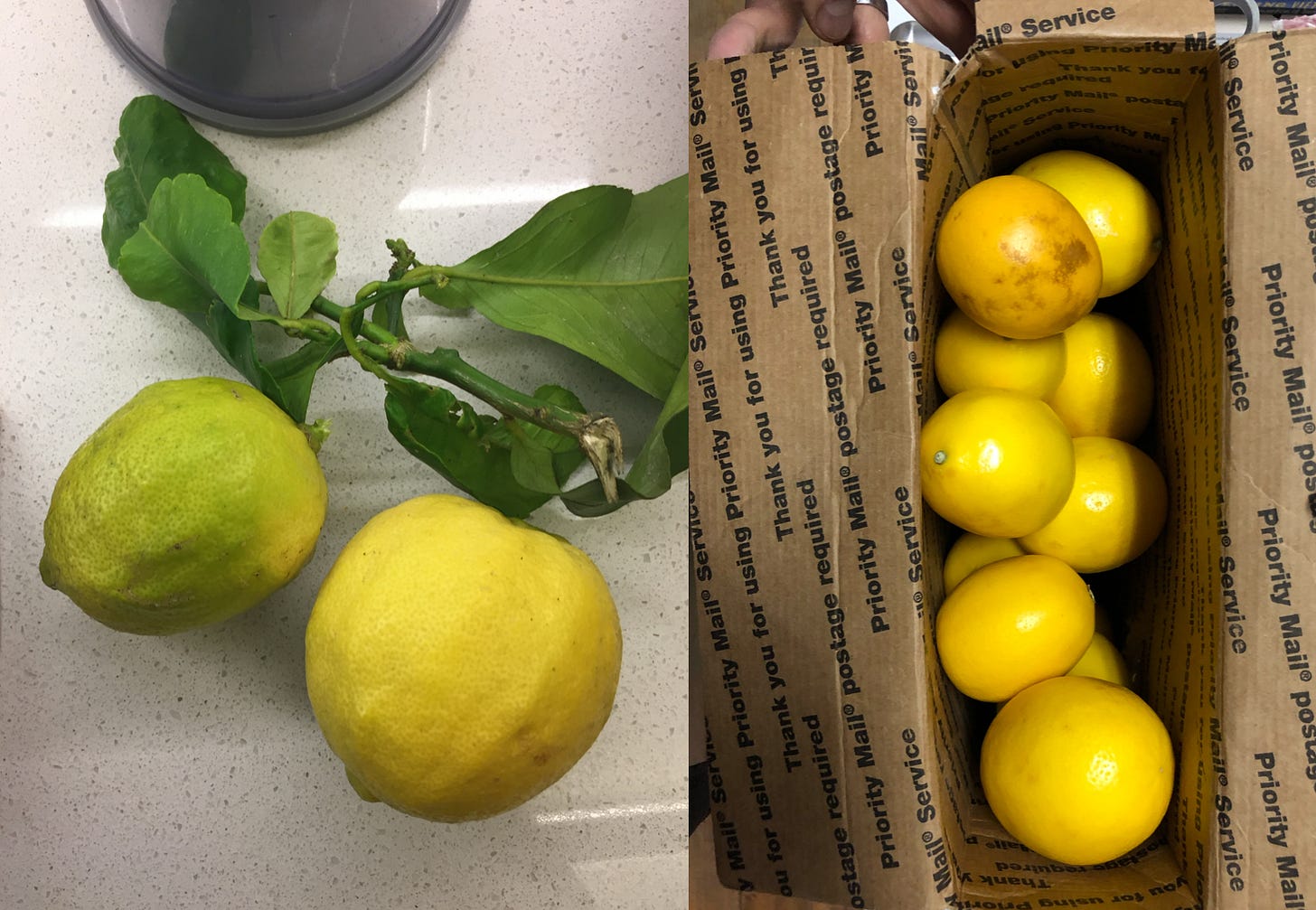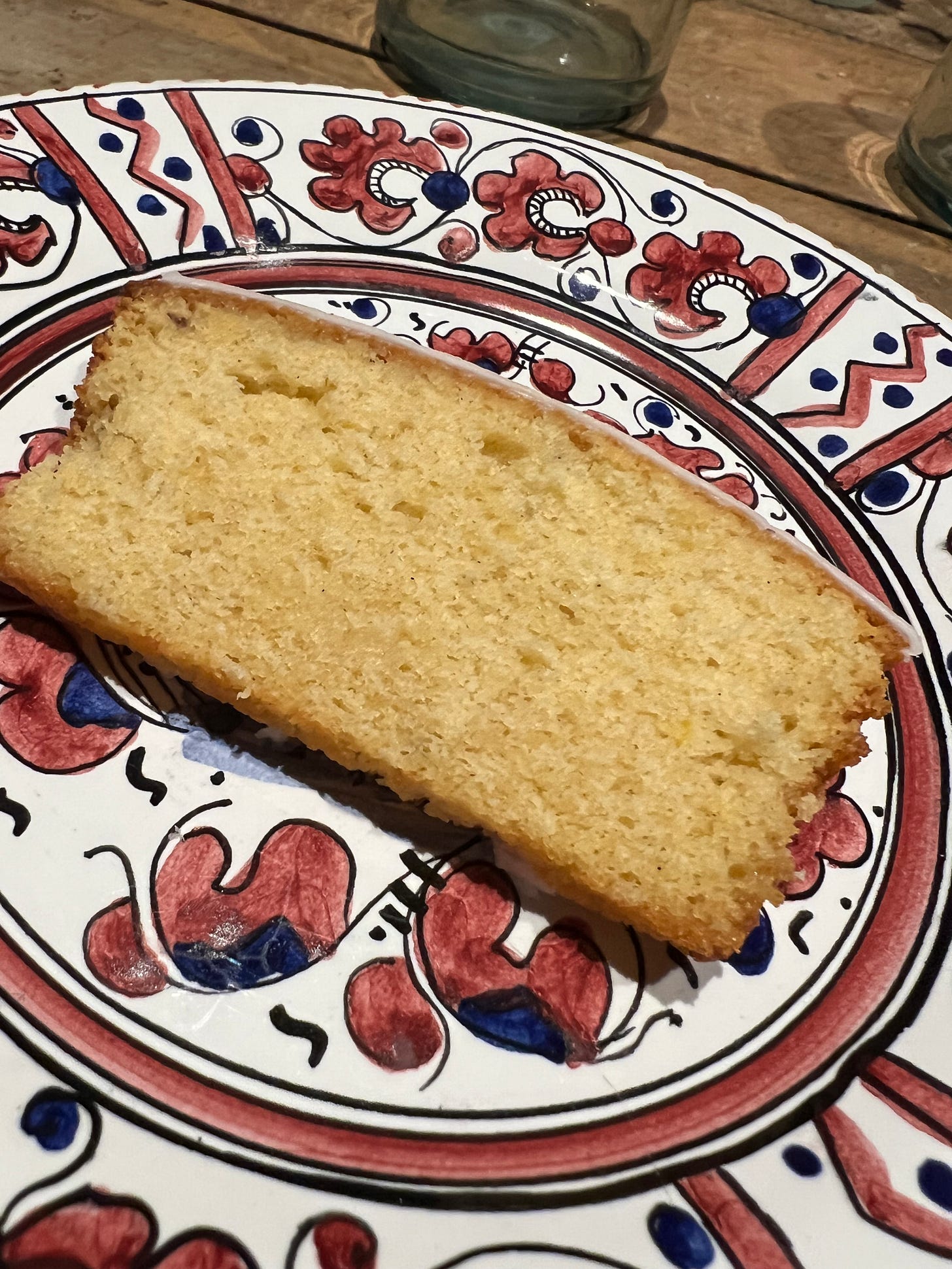Issue #198: Lavender Lemon Drizzle Loaf
Updating a Common Cake, For the Love of (Culinary) Lavender
Although lemons and most citrus are plentiful in grocery stores year-round, they actually have a season: winter. How can you tell? The fruit is bigger, juicier, more flavorful, and cheaper than it is during other times of the year. Nowadays in New England, when the sun stays up longer and the mercury is rising, but there’s still snow on the ground and it’s too soon for anything edible to poke through, lemons can seem like a burst of sunshine and hope.
Tasked with bringing dessert to dinner at the home of colleagues of Nate’s this past weekend, I opened my fridge to find inspiration. The fruit drawer was filled with a selection of citrus that included clementines, blood oranges, so-called heirloom navel oranges, Cara Cara oranges, and lemons. The last appealed. It was the first day of Daylight Savings Time. The sun was shining. The snow had begun to thaw. The end of citrus season was nigh. I love lemon.

Though a personal favorite, a simple lemon pound cake didn’t seem enough to make a first impression. I opted for a favorite British lemon drizzle recipe—like “red velvet,” the term “lemon drizzle” attracts attention—which I decided to enhance with dried lavender. The combination of lemon and lavender is one I adore, one that seems more exotic than it ought. I have a jar of lavender grown on the terrace of our apartment in Manhattan and house-dried, so to speak. I don’t always remember it exists, but when I do, it makes me happy to sprinkle it about.
Before you dismiss lavender in the kitchen as too evocative of your grandmother’s soap dish, hear me out. There are some 47 different varieties of the Lavandula genus, of which only one is well suited to the kitchen. The predominant aromatic, floral lavenders give Provençal soaps and perfumes their distinctive scent. But the flavor of culinary lavender, Lavandula angustifolia or “English” lavender, is herbaceous, not flowery. It adds an intriguing complexity to a wide variety of dishes, both savory and sweet.
Many years ago, at the amazing farmers market behind San Francisco’s Ferry Building, I happened on a memorable open-faced smoked salmon sandwich on sourdough that was seasoned with lavender salt. So excited by the notion of this accent was I, that as soon as I got home, I ground together some sea salt with a generous amount of dried lavender to recreate it. (I still have a few tablespoons of the stuff left.)
Then there’s Daniel Humm’s famous honey lavender roast duck, a signature at pre-COVID, pre-VEGAN Eleven Madison Park, that no doubt help catapult the restaurant to the top spot on the World’s 50 Best Restaurants ranking. (I may have been the regional Academy Chair for those awards at the time and I may have enjoyed that duck on several different occasions.) Although you can still eat very well at the restaurant's vegan incarnation, I miss the toothsomeness and chew of that decidedly carnivorous creation.
When thinking about lavender in dessert, I often think about Phyllis, my former colleague at the James Beard Foundation, who has a predilection for lavender-scented shortbread.
Yes, a lemon lavender drizzle cake is what I would bake.
I’m not totally sure what constitutes a lemon drizzle cake—curiously, the internet tells me it was invented by a Jewish British baker in the 1960s—but it’s usually bathed in syrup and glazed. I added lavender to my batter, not too much, and garnished the top with dried buds. I can presume the result was a success because people helped themselves to seconds and despite some heated political conversation over dinner, we’ve been invited back.
RECIPE: Lavender Lemon Drizzle Loaf
Makes one cake, about 8 servings
1 1/2 cups all-purpose flour
1 1/2 teaspoons baking powder
1/2 teaspoon fine sea salt
1 cup granulated sugar
Zest of 1 lemon (about 1 tablespoon)
1 teaspoon dried lavender buds, plus more for garnish
1/2 cup (1 stick) unsalted butter, at room temperature
2 large eggs
1 teaspoon vanilla
Juice of 2 lemons (about 1/3 cup)
1/2 cup buttermilk or sour milk
1 cup plus 3 tablespoons icing sugar
1 tablespoon milk
Preheat the oven to 350°F. Grease an 8” by 4” loaf pan and line with parchment coming up the sides. Grease the parchment paper.
In a medium bowl, combine the flour, baking powder and salt. In another medium bowl, combine the sugar, lemon zest, and lavender, and rub the zest and lavender into the sugar to release their essential oils. The sugar should become a little clumpy, like wet sand.
In the bowl of an electric mixer, combine the softened butter and the sugar mixture and beat on medium until light and fluffy, scraping down the sides of the bowl from time to time. Add the eggs, one at a time, beating until fluffy between each addition. Add the vanilla and 2 tablespoons of the lemon juice, and continue beating until incorporated. Don’t worry if the mixture looks a little curdled, it will come back together when you add the other ingredients.
Remove the bowl from the mixer and dump in about 1/3 of the flour mixture. Stir with a rubber spatula or wooden spoon until almost fully incorporated. Add 1/2 the buttermilk or sour milk, stir, and then add another 1/3 of the flour. Repeat with the remaining milk and flour, stirring just until everything is incorporated. Don’t overmix.
Transfer the cake batter to the prepared loaf pan, spreading out the top evenly with an offset spatula. Bake for 45 to 50 minutes, or until the cake has risen, set, and browned around the edges. An instant-read thermometer should reach at least 200°F. when inserted in the center. Remove the cake to a wire rack to cool in the pan for 15 minutes.
Meanwhile, prepare a lemon syrup by combining 1/4 cup of the lemon juice with 3 tablespoons of the icing sugar. Beat with a small whisk to remove any lumps. Heat this mixture in a microwave for about 30 seconds until warm and the sugar has fully dissolved.
After the cake has cooled for 15 minutes (it will still be warm), run a thin knife between the parchment and the pan and then lift the cake onto the wire rack, right side up. Carefully pull down the parchment from the sides, but leave the bottom parchment intact to catch any syrup. Using a pastry brush, brush the lemon syrup all over the surface of the cake, including the sides. (Dip the brush in the syrup and then dab the sides to moisten them.) Use up all the syrup. Allow the cake to cool completely, about another hour or so.
To make the glaze, place the remaining cup of icing sugar in a small bowl. Add the tablespoon of milk and a tablespoon of the remaining lemon juice, and stir to form a smooth glaze. Dribble a few drops more of lemon juice or milk until you have a thick, but pourable glaze. Carefully peel off all the parchment and return the naked cake to the wire rack. Pour the glaze over the top of the cooled cake, spreading it with the back of a spoon and encouraging it to drip down the sides. If you need more glaze, use a spatula to scoop it up from under the rack and put it back on the top of the cake. Garnish with a scattering of lavender buds and allow the glaze to harden for a few minutes before serving.





